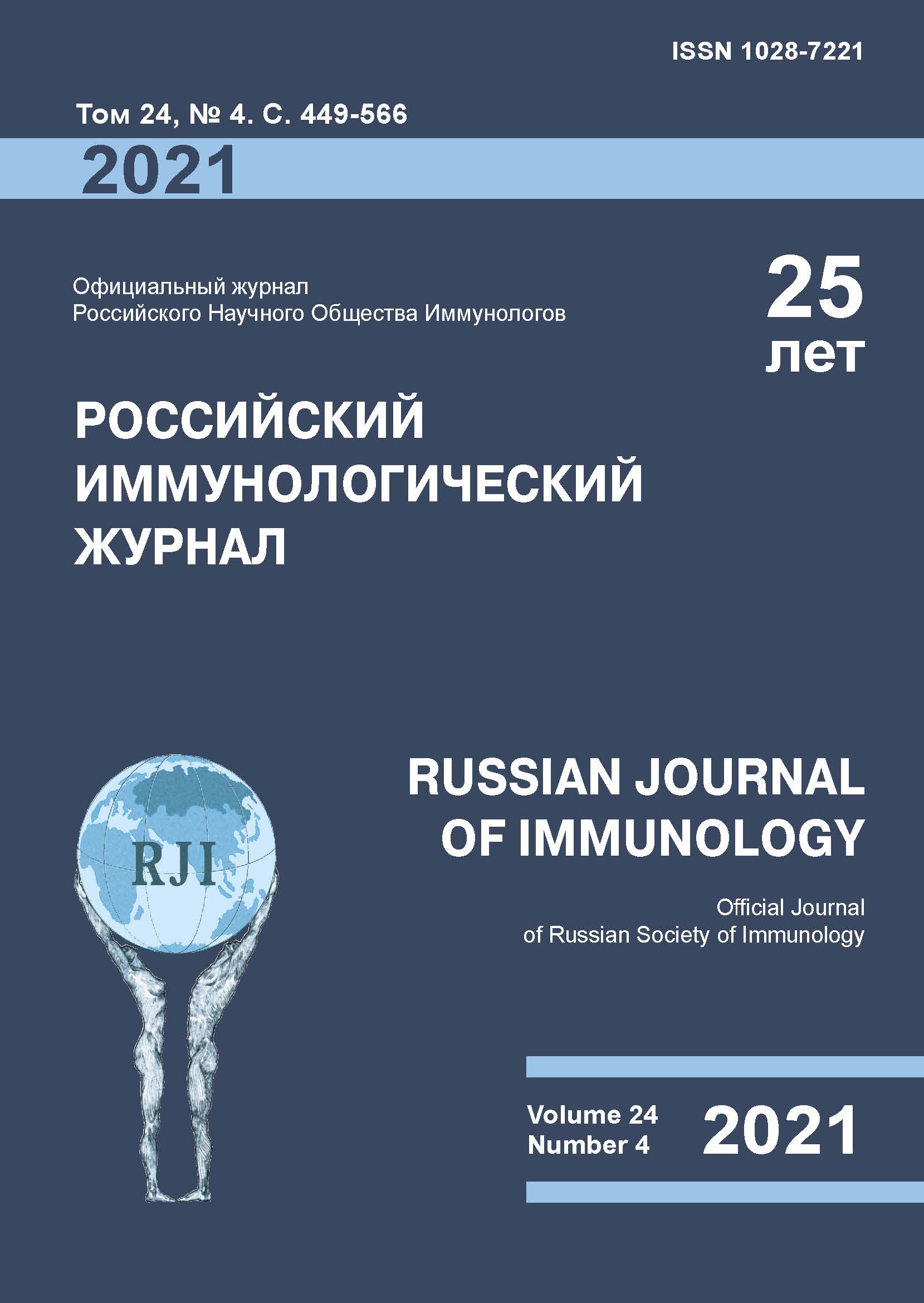Об особенностях содержания интерферонов-лямбда в сыворотке крови у пациентов с ВИЧ-инфекцией
- Авторы: Кныш С.В.1, Скляр Л.Ф.1,2, Маркелова Е.В.1, Кузнецов А.С.1, Соловьева Н.П.2, Левенец М.А.1
-
Учреждения:
- ФГБОУ ВО «Тихоокеанский государственный медицинский университет» Министерства здравоохранения РФ
- ГБУЗ «Краевая клиническая больница № 2»
- Выпуск: Том 24, № 4 (2021)
- Страницы: 489-494
- Раздел: КРАТКИЕ СООБЩЕНИЯ
- Дата подачи: 19.07.2021
- Дата принятия к публикации: 20.08.2021
- Дата публикации: 15.10.2021
- URL: https://rusimmun.ru/jour/article/view/1059
- DOI: https://doi.org/10.46235/1028-7221-1059-SFO
- ID: 1059
Цитировать
Полный текст
Аннотация
Важным вопросом для современной медицины остается исследование ВИЧ-инфекции, которая, благодаря повсеместному применению антиретровирусной терапии, приобретает контролируемый характер, но в то же время не поддается полному излечиванию и имеет ряд «белых пятен» в понимании иммунопатогенеза нарушений, сопутствующих данному заболеванию. Целесообразно глубокое изучение системы интерферонов, в частности из семейства лямбда, в связи с их противовирусной активностью у пациентов с ВИЧ-инфекцией. Цель исследования – провести оценку содержания представителей семейства интерферонов-лямбда – IFNλ1 (IL-29) и IFNλ3 (IL-28В) у пациентов с ВИЧ-инфекцией.
Был проведен анализ сыворотки крови 120 пациентов с ВИЧ-инфекцией (средний возраст 49,7±6,2 года), находящихся на амбулаторном лечении в Центре профилактики и борьбы со СПИД ГБУЗ ККБ № 2 г. Владивостока. Основной клинический диагноз всех пациентов: ВИЧ-инфекция 4 А. Стадия вторичных заболеваний. Фаза ремиссии на фоне приема АРВТ. У 52 пациентов было установлено сопутствующее заболевание: хронический вирусный гепатит С. Определение содержания IFNλ1 (IL-29) и IFNλ3 (IL-28В) в сыворотке венозной крови осуществлялось методом твердофазного иммуноферментного анализа (ИФА), с использованием анализатора Multiscan. Для проведения ИФА использовались реактивы, произведенные R&D systems, каталожные номера DY5259; DY7246.
В группах пациентов с ВИЧ-инфекцией, как с вирусным гепатитом С, так и без него, значения IFNλ1 (IL-29) и IFNλ3 (IL-28В) были достоверно снижены в сравнении с группой контроля. При сравнении значений между группами, было выявлено более выраженное уменьшение уровня IFNλ1 (IL-29) в группе пациентов с вирусным гепатитом С. Анализируя уровень IFNλ3 (IL-28В) была выявлена противоположная картина, – значения в группе пациентов с ВИЧ-инфекцией и вирусным гепатитом С были выше, чем в группе без гепатита, однако не достигали значений контрольной группы.
Основываясь на данных о противовирусном влиянии IFNλ3 (IL-28В) на макрофагальную передачу ВИЧ, можно предположить, что индукция и поддержание высокого уровня интерферонов третьего типа могут благоприятно сказаться на течении ВИЧ-инфекции. Зарегистрированные изменения в уровне IFNλ1 (IL-29) и IFNλ3 (IL-28В) у пациентов с ВИЧ и ВГС демонстрируют нам вирусное влияние на врожденный иммунитет, характеризующееся разнонаправленным изменением при наличии или отсутствии вируса гепатита С. Изучение данных об изменениях врожденного иммунитета и роли интерферонов третьего типа может расширить понимание взаимодействия между организмом человека и ВИЧ и поспособствовать улучшению профилактических мероприятий и реабилитации у пациентов с ВИЧ-инфекцией.
Ключевые слова
Об авторах
С. В. Кныш
ФГБОУ ВО «Тихоокеанский государственный медицинский университет» Министерства здравоохранения РФ
Автор, ответственный за переписку.
Email: immunolog.vl@gmail.com
ORCID iD: 0000-0003-4571-1749
к.м.н., доцент кафедры нормальной и патологической физиологии
SPIN-код: 9170-3654
690105, Россия, г. Владивосток, ул. Русская, 57к, кв. 107
Тел.: 8 (995) 773-65-23
РоссияЛ. Ф. Скляр
ФГБОУ ВО «Тихоокеанский государственный медицинский университет» Министерства здравоохранения РФ;ГБУЗ «Краевая клиническая больница № 2»
Email: lidiya.sklyar@hotmail.com
д.м.н., профессор, заместитель главного врача по профилактике и борьбе со СПИД и инфекционными заболеваниями; профессор кафедры инфекционных болезней
Е. В. Маркелова
ФГБОУ ВО «Тихоокеанский государственный медицинский университет» Министерства здравоохранения РФ
Email: markev2010@mail.ru
д.м.н., профессор, заведующая кафедрой нормальной и патологической физиологии
А. С. Кузнецов
ФГБОУ ВО «Тихоокеанский государственный медицинский университет» Министерства здравоохранения РФ
Email: agent_zeborivch@mail.ru
аспирант кафедры нормальной и патологической физиологии
Н. П. Соловьева
ГБУЗ «Краевая клиническая больница № 2»
Email: patphis-vl@mail.ru
к.м.н., врач-инфекционист
М. А. Левенец
ФГБОУ ВО «Тихоокеанский государственный медицинский университет» Министерства здравоохранения РФ
Email: maks_levenets22@mail.ru
студент военного-учебного центра
Список литературы
- Малов С.И., Малов И.В., Колбасеева О.В., Степаненко Л.А., Дулгуун Б., Хабудаев В.А., Ющук Н.Д. Динамика синтеза интерферона-лямбда-1 у больных острым вирусным гепатитом С // Инфекционные болезни: новости, мнения, обучение, 2016. № 2. С. 78-83.
- Angel C.J.L., Pham E.A., Du H.,Vallania F., Fram B.J., Perez K., Nguyen T., Rosenberg-Hasson Y., Ahmed A., Dekker C.L., Grant P.M., Khatri P., Maecker H.T., Glenn J.S., Davis M.M., Furman D. Signatures of immune dysfunction in HIV and HCV infection share features with chronic inflammation in aging and persist after viral reduction or elimination. Proc. Natl. Acad. Sci. USA, 2021, Vol. 118, no. 14, e2022928118. doi: 10.1073/pnas.2022928118.
- Bellanti F., Vendemiale G., Altomare E., Serviddio G. The impact of interferon lambda 3 gene polymorphism on natural course and treatment of hepatitis C. J. Immunol. Res., 2012, Vol. 2012, 849373. doi: 10.1155/2012/849373.
- Boisvert M., Shoukry N.H., Type III interferons in hepatitis C virus infection. Front. Immunol., 2016, Vol. 7, 628. doi: 10.3389/fimmu.2016.00628.
- Bruening J., Weigei B., Gerold G. The role of type III interferons in hepatitis C virus infection and therapy. J. Immunol. Res., 2017, Vol. 2017, 7232361. doi: 10.1155/2017/7232361.
- Casado C., Galvez C., Pernas M., Tarancon-Diez L., Rodriguez C., Sanchez-Merino V., Vera M., Olivares I., Pablo-Bernal R., Merino-Mansilla A., Romero J.D., Lorenzo-Redondo R., Ruiz-Mateos E., Salgado M., MartinezPicado J., Lopez-Galindez C. Permanent control of HIV-1 pathogenesis in exceptional elite controllers: a model of spontaneous cure. Sci. Rep., 2020, no. 10, 1902. doi: 10.1038/s41598-020-58696-y.
- Chaturvedi, N., Svarovskaia E.S., Mo H., Osinusi A.O., Brainard D.M., Subramanian G.M., McHutchinson J.G., Zeuzem S., Fellay J. Adaptation of hepatitis C virus to interferon lambda polymorphism across multiple viral genotypes. eLife, 2019, Vol. 8, e42542. doi: 10.7554/eLife.42542.
- Friborg J., Ross-Macdonald P., Cao J., Willard R., Lin B., Eggers B., McPhee F. Impairment of type I but not type III IFN signaling by hepatitis C virus infection influences antiviral responses in primary human hepatocytes. PLoS One, 2015, Vol. 10, no. 3, 0121734. doi: 10.1371/journal.pone.0121734.
- Goel R.R., Kotenko S.V., Kaplan M.J. Interferon lambda in inflammation and autoimmune rheumatic diseases. Nat. Rev. Rheumatol., 2021, Vol. 17, no. 6, pp. 349-362.
- Liu M., Zhou D., Wang X., Zhou W., Ye L., Li J., Wang Y., Ho W. IFN-λ3 Inhibits HIV infection of macrophages through the JAK-STAT Pathway. PLoS One, 2012, Vol. 7, no. 4, e35902. doi: 10.1371/journal.pone.0035902.
- Syedbasha M., Egli A. Interferon lambda: modulating immunity in infectious diseases. Front. Immuno., 2017, Vol. 8, 119. doi: 10.3389/fimmu.2017.00119.
Дополнительные файлы







